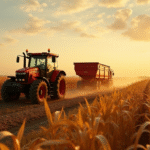Introduction
On Friday, futures for Chicago soybeans and corn increased following the release of a less-than-surprising but bearish monthly crop report by the United States Department of Agriculture (USDA).
USDA’s Crop Report Details
The USDA reported that US farmers will harvest the largest acreage of corn since 1933 and produce more grain than initially anticipated, despite crop yields failing to meet previous forecasts. The agency further increased its acreage estimate in the monthly supply and demand report, following August’s surprise increase that left grain traders pleasantly surprised.
Market Reactions
- Soybeans: The most active soybean contract on the Chicago Board of Trade (CBOT) rose by 14.25 cents to $10.4775 per bushel.
- Corn: CBOT corn increased by 7.25 cents to $4.27 per bushel.
- Wheat: CBOT wheat decreased by 0.5 cents to $5.21 per bushel, as global abundance has kept wheat prices in check.
USDA’s Production Estimates
The USDA raised its projected US corn production for 2025 to a record-high of 16.814 billion bushels, up from the previous month’s estimate of 16.742 billion bushels. For soybeans, the USDA projected a yield of 53.5 bushels per acre in 2025, down from the previous month’s estimate of 53.6 bushels per acre.
Challenges Facing US Agriculture
High levels of fungal diseases in the Midwestern US cornfields threaten to lower yields, according to farmers and crop experts. Meanwhile, China’s reduced demand due to a trade war with Washington looms over the soybean market, causing US farmers to lose sales to the Asian giant.
Key Questions and Answers
- What is the USDA’s role? The USDA is a federal executive department responsible for developing and executing policies to promote the economic well-being of US agricultural sector.
- Why are the USDA’s crop reports significant? These reports provide crucial information on US agricultural production, helping farmers, traders, and investors make informed decisions regarding crop planting, pricing, and trading.
- What factors are affecting corn and soybean yields? High levels of fungal diseases in Midwestern cornfields and reduced demand from China due to trade tensions are negatively impacting crop yields.






